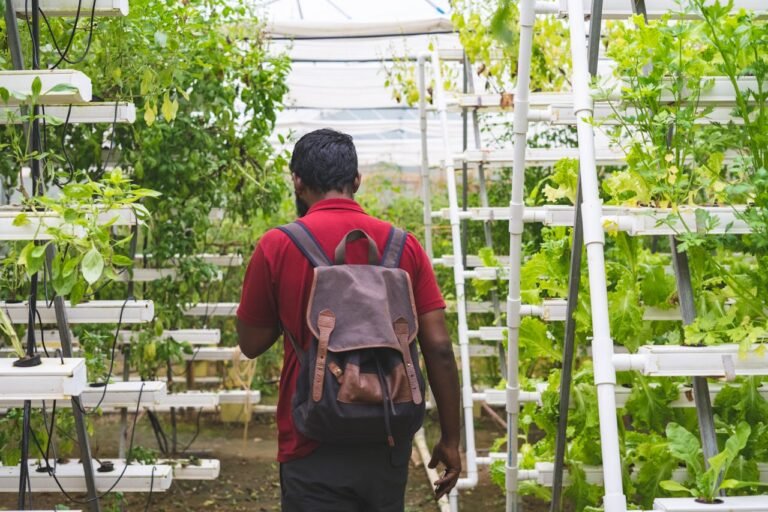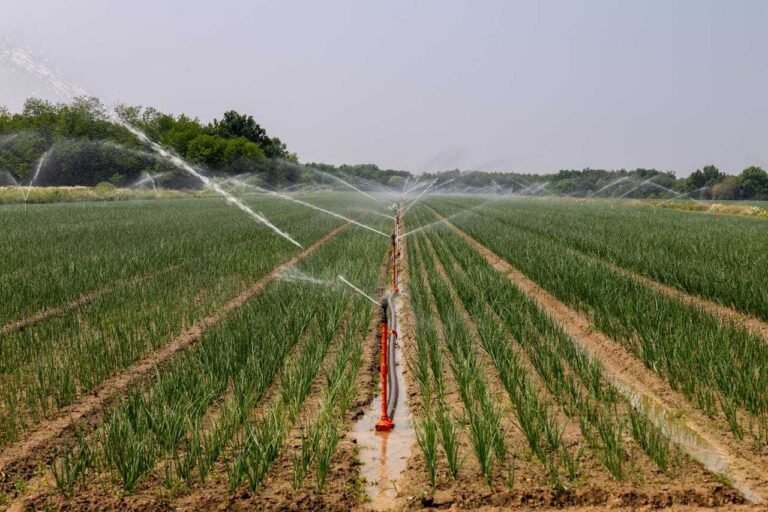Agroforestry Boosts Climate Resilience and Economic Growth, Study Finds
Agroforestry is defined as the intentional integration of trees, shrubs, crops, and sometimes livestock on the same land to create balanced systems that deliver both ecological and economic value.
Rather than treating farming and forestry as separate, this approach blends them naturally. It’s a method that’s gaining traction not just for what it produces, but for how it sustains. Whether in the tropics or temperate zones, farmers are using agroforestry to heal degraded soils, secure diverse harvests, and buffer against climate shocks.
Recent research—including a 2025 Yale-led study—highlights its potential to store carbon, revive biodiversity, and improve rural incomes through well-managed, multi-layered systems. In places like Punjab, India, simple boundary plantings of fast-growing trees like poplar are quietly transforming fields, reducing erosion while increasing farm profits with little extra input. Agroforestry, in essence, reimagines the farm as a living, regenerative ecosystem that works with nature rather than against it.

In This Article
- Why Agroforestry Matters for the Climate
- Cash Crops: Agroforestry’s Bottom-Line Benefits
- Real‑Life Success: Farmer Narratives
- Programs & Policy
- Actionable Takeaways for Readers
Why Agroforestry Matters for the Climate
1. Carbon in the Soil and the Stock
A 2023 review led by The Nature Conservancy found that integrating trees into farmland could represent the single most significant climate action within agriculture, rivalling reforestation in its impact. A study estimates that global agroforestry could sequester between 12 and 19 petagrams of carbon (PgC), and even small increases in tree cover could store 4–6 PgC.
Examples from temperate zones, such as multistrata farms in Europe, show that these systems can boost farm productivity by 36% to 100% compared to monocultures, while also increasing the amount of organic matter in the soil. A meta-analysis of European agroforestry systems found that both biomass production and soil health perform better under tree–crop integration.
Looking at tropical regions, research on Ethiopian coffee–banana–chile systems reveals how much carbon the soil can store. These farms—some between 10 and 54 years old—maintain dense, multi-layered tree cover that retains both carbon and nitrogen, far outperforming single-crop fields.
A global dataset from the Centre for International Forestry Research (CIFOR-ICRAF) and partners, published in 2022, projects that a 10% increase in tree cover on farmland worldwide could add more than 18 PgC to carbon stocks. That’s equivalent to removing billions of tons of CO₂ from the atmosphere—a climate win with real impact.
2. Biodiversity and Adaptation
But agroforestry isn’t just about carbon. It works with nature to support wildlife, buffer crops from weather extremes, and build long-term resilience.
Trees in these systems provide crucial habitat for pollinators—bees, butterflies, and other insects—that boost crop yields and stabilise ecosystems. According to global biodiversity research, trees and hedgerows in agricultural landscapes support these services, maintaining genetic diversity and pesticide-free pest control.
That’s vital because up to 75% of major global crops rely on pollinators. Diverse, flowering landscapes in agroforestry zones mean pollinators always find food and shelter across seasons.
Beyond pollination, agroforestry helps stabilise microclimates. Deep-rooted trees enhance soil structure and moisture retention, reducing erosion and helping buffer crops from droughts and intense heat. In silvopasture systems—where trees, livestock, and grass coexist—farmers report improved yields and reduced livestock heat stress, especially during hot, dry seasons.
Animal and plant biodiversity thrives, too. In Europe, studies show that agroforestry outperforms both conventional farmland and even some commercial forests in terms of supporting birds, insects, and soil life. Tropical agroforestry systems, like shade-grown coffee and cacao, restore native species while still yielding profitable harvests.
These systems also build resilience. A meta-review covering 50 years found that diversified farming—including agroforestry—led to stronger soil structure, better water use, richer biodiversity, and even long-term profitability improvements of up to 2,800% over monocultures.
Cash Crops: Agroforestry’s Bottom-Line Benefits
1. Boosting Farmer Incomes
A 2024 study from Ethiopia found that agroforestry made up roughly 69% of participating households’ cash income, based on products like coffee, fruits, and wood. This shift means farmers can better afford essentials like food, shelter, and school fees. In Ghana and Ethiopia, revenues from cocoa and coffee grown within tree-based systems have enabled families to purchase food and improve living standards.
In the tropics, farmers integrating fruit or nut trees with staple crops like cassava and maize report significant income growth. One Amazon project saw incomes per acre jump from about $520 to over $2,400 after transitioning to an agroforestry model that included timber and fruit trees alongside cassava. These real-world examples show that combining trees and crops can boost earnings substantially and sustainably.
2. Reducing Input Costs
Trees in agroforestry systems offer natural boosts to soil health, reducing or replacing the need for expensive chemical fertilisers. “Fertiliser trees”—leguminous trees like Faidherbia albida—fix nitrogen in the soil, increasing maize yields from 1 to over 10 tons per hectare in some African regions. This not only raises yields but cuts out costly synthetic fertilisers.
Beyond soil nutrition, trees also bring other free benefits. They serve as windbreaks, reduce erosion, help retain moisture, and suppress pests, lowering the need for costly pesticides and irrigation. Research shows that agroforestry is generally a “low‑cost alternative practice” that still yields strong returns, especially over the long run.
3. Income Diversity & Stability
Mono‑cropping leaves farmers vulnerable to one bad season or a market crash. Agroforestry diversifies income by adding timber, fruits, nuts, medicinal plants, or even livestock into the mix. That’s what the Kenyan “shamba” system has done for generations—blending bananas, beans, corn, timber, beekeeping, and herbs to generate steady, varied revenue.
Diversification isn’t just a hedge—it’s a stabiliser. A study of smallholder farms in southern Mexico showed that greater crop species diversity significantly enhances revenue stability—portfolios centred around staples like maize tended to have lower stability compared to more diverse mixes that included sugar or other crops. For smallholder farmers, especially in East Africa, tree income acts as a “safety net” when staple crops fail or markets dip.
Learn More: Permaculture: Definition, Principles & Examples
Real‑Life Success: Farmer Narratives
1. Brazil’s Amazon Guardrails
In Pará, Brazil, farmer Nestor Porfirio and his peers faced declining yields after years of monoculture drained their land. As they turned to agroforestry—planting multiple tree and crop species side by side—they saw rapid results. According to a Time article, their soils rejuvenated and household incomes doubled within just two years. For Nestor, this shift brought abundance: he could harvest fruit and timber, grow diverse crops, and even tap into carbon-credit markets, creating a resilient income stream where none existed before.
2. Kenya’s Forest Gardens
Around Lake Victoria, Trees for the Future supports 17,000 farmers in establishing one‑hectare “forest gardens”—each packed with over 5,000 trees and surrounded by windbreaks. These gardens help rebuild soil, diversify produce, and establish emerging carbon-payment systems. Kenyan project lead Vincent Mainga explains: “This model is very easy to adopt… after four years they can produce thriving farmlands… self‑sustaining.” By 2024, hundreds of participants had completed the program, reporting improved harvests, healthier soils, and more stable incomes, which reflects its growing impact on rural livelihoods.
3. India’s Smallholder Success
In India’s northeast—specifically Meghalaya—a 2023–24 report by ICAR and regional studies found that integrating guava into rice fields tripled net returns, while lemon cultivation nearly doubled income. Beyond fruits, the state’s MegCare programme, launched in January 2024, pays farmers €40 per Carbon Removal Unit—the highest such payment in India—to plant multi-species agroforestry across 22,000 hectares, covering more than 10,000 farmers so far. These schemes elevate small-scale landholdings into climate-smart, profitable farms, yielding both ecological benefits and healthy returns.
Programs & Policy
National Agroforestry Policy (India)
Launched in 2014, India’s policy encourages small farmers to blend trees with crops and livestock, aiming to boost farm income and heal degraded lands. The government targets restoring 26 million hectares and wants agroforestry to fuel carbon sinks by 2030. In June 2025, India rolled out streamlined rules to make it easier to fell and sell trees grown on farms, cutting through red tape and helping rural communities benefit from timber and fruit sales .
Yet on-the-ground adoption remains modest—across a decade, agroforestry expanded by just 0.45 % of India’s total land, highlighting gaps in land rights clarity, outreach services, and market access.
Global Programs
Private sector leaders are stepping in. According to a report by Reuters, luxury brands such as Armani, LVMH, and H&M are testing agroforestry-grown cotton and coffee to support farmers’ livelihoods and promote sustainable sourcing.
Meanwhile, in the United States, only 1.5% of farms have agroforestry systems, but this practice is gaining traction. The latest Farm Bill and USDA regional centre efforts are pushing support for alley cropping, windbreaks, silvopasture, and riparian buffers.
Barriers and Solutions
For many farmers, the first big challenge with agroforestry is the upfront cost. It’s not just about planting a few trees—it involves buying quality seedlings, putting up fences, and learning new skills. That kind of investment can feel overwhelming, especially for smallholders. But cost-sharing programs are making it easier. Take Sri Lanka’s 4P model, for example, where public, private, and producer partners share the burden. Similarly, in the U.S., programs like USDA’s Climate-Smart Commodities initiative cover up to 95% of tree planting costs for underserved farmers. These kinds of partnerships are turning big barriers into manageable first steps.
Then there’s the knowledge gap. Agroforestry isn’t just farming with trees—it’s knowing how trees and crops interact, when to prune, what species to mix, and how to time it all. That’s why farmer-to-farmer learning circles and community training hubs are so valuable. In Brazil and the Philippines, these networks are helping farmers teach one another in practical, local ways that stick.
Market access is another sticking point. A farmer might grow new products, but without buyers or fair prices, it’s a dead end. In São Tomé and Príncipe, the cocoa cooperative CECAB changed that. By helping 3,000 farmers grow organic, fair-trade cocoa and process it locally, many now earn about 60% of their household income from cocoa, more than double what it used to be. Cooperatives like this don’t just create markets—they build stability.
And finally, there’s the issue of land rights. If a farmer isn’t sure they’ll still have access to the land in ten years, why plant trees today? In places like Burkina Faso, tools like the Land Negotiation Guide are helping clarify land tenure, while in India, new agroforestry policies are giving farmers the legal backing they need to invest long-term.
Actionable Takeaways for Readers
Farmers & Cooperatives
Start small — for example, planting legumes like Desmodium or small fruit trees alongside staples helps boost soil nutrients and resilience. A 2025 review found that cereal–legume intercropping significantly improved agricultural resilience across Africa. Reach out to local agroforestry centres or extension services to learn techniques via on‑farm trials or farmer-to-farmer groups. Explore financing options such as microloans, Payment for Ecosystem Services (PES), or voluntary carbon schemes; a 2025 analysis showed PES can directly incentivise agroforestry adoption.
Policymakers
Fund initial agroforestry investments using subsidies, risk-sharing mechanisms, or improved land tenure. Strengthen extension networks and support mentoring systems where experienced farmers train peers. Invest in infrastructure and market linkages—processing facilities for tree products like biochar, nuts, timber—to make agroforestry financially viable.
Businesses & Investors
Create supply chains rooted in agroforestry for commodity resilience and brand integrity. Prioritise traceability and certification in products such as coffee, cocoa, and cotton. Leverage voluntary carbon credits—recent reviews highlight agroforestry’s strong carbon‑sequestration potential.
Consumers & Citizens
Support products from agroforestry‑aligned brands. Use your voice to push for deforestation‑free commodity policies locally and globally—consumer pressure helped reduce Amazon deforestation linked to agriculture.
Learn More: Environmental Impact of Traditional Agriculture & Farming
Conclusion
Agroforestry bridges climate and commerce in a tangible way. For families in Brazil, mixed orchards mean stable income and restored soils. For farmers in India and Kenya, it’s been a turnaround—boosted yields, stronger livelihoods, and enhanced resilience. Across continents, agroforestry integrates mitigation (carbon storage), adaptation (buffering weather extremes), income diversification, and biodiversity—all in one living system.
Agroforestry isn’t a niche—it’s foundational. Transitioning from conventional agriculture to agroforestry demands investment, expertise, and policy commitment. But the payoff—a win for climate, a win for farmers, a win for communities—is profoundly clear.







